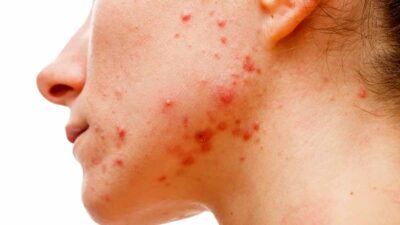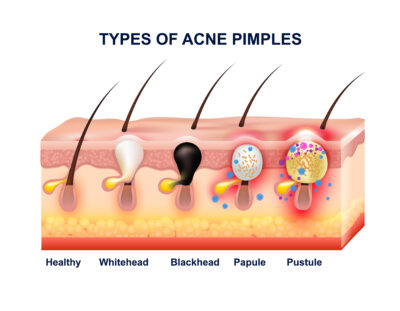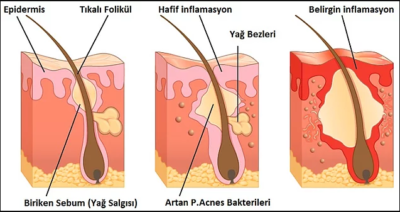Contents
Acne Treatment
 Acne is a common skin problem in both men and women. It usually begins to form during adolescence. It is a skin condition that affects 85 out of every 100 young people. But it doesn’t just occur during adolescence. Acne, which is called adult type, is especially common after the age of 40. This type of acne is more common in women. The most obvious difference of these late acnes from those that occur in adolescence is that they are more resistant to treatment.
Acne is a common skin problem in both men and women. It usually begins to form during adolescence. It is a skin condition that affects 85 out of every 100 young people. But it doesn’t just occur during adolescence. Acne, which is called adult type, is especially common after the age of 40. This type of acne is more common in women. The most obvious difference of these late acnes from those that occur in adolescence is that they are more resistant to treatment.
Acne formation corresponds to the age of 10-17 in adolescent girls and 14-19 years of age in boys. Men are more likely to get acne breakouts. Acne does not threaten health. However, pimples that start to appear during adolescence and continue to appear in later years can impair psychological health along with the appearance. If these acnes are not treated at the right time with an appropriate treatment method, they can turn into serious permanent scars and stains called scars.
When it comes to acne, the first thing that comes to mind is the face, but acne also occurs in different parts of the body other than the face. Apart from the face, acne usually occurs on the back, neck, chest, shoulders and upper arms. The excess of sebaceous glands in these areas invites the formation of acne. Normally, the oil secreted by these glands goes to the surface of the skin and is excreted from the body. But in adolescence, the sebaceous glands secrete more oil than necessary. Thus, the channels that allow this oil to pass to the skin surface are blocked. This accelerates the formation of acne.
What is acne?
Acne is a skin condition that occurs in hair follicles and areas of the body with sebaceous glands. The sebaceous glands secrete sebum to maintain the moisture balance of the skin. As the production continues as a result of the occlusion of the sebaceous glands, inflamed acne occurs as cysts and then infection. Acne is a very common health problem. Acne occurs in people of all races and ages. Not only in adolescence, but also in later ages, people can suffer from acne problems. But it is most common during adolescence. During puberty, androgen levels increase in both girls and boys. As a result, the sebaceous glands begin to produce more oil. Normally, sebum passes from the hair follicles to the skin. However, skin cells clog the follicles and sebum passage is blocked. When these follicles are clogged, the bacteria in the skin grows inside these follicles. Thus, acne formation begins.
Why does acne occur? What are the factors affecting acne formation?
The causes of acne formation vary from person to person. The hormonal level that changes during adolescence triggers the formation of acne. But in general, the appearance of acne on the body depends on genetic predisposition. The main factors affecting the formation of acne are as follows:
– Structural features
– Hormonal imbalances
– Extremely stressful life
– Increased sebum production
– Changes in the Hair Follicle
– Bacteria
– Oily skin structure
– Misuse of cosmetic products and some drugs used.
The most important factor affecting the formation of acne is the structural features. It is more common in people with a family history of severe acne. These people should benefit from early diagnosis and treatment. Apart from genetic features, an extremely stressful life, excessive and incorrect use of cosmetic products applied to the skin outside the doctor’s control, as well as hormonal changes invite the formation of acne. Fat secretion, which increases in the body, is also among other important factors. People with larger sebaceous glands are more likely to develop acne. Compared to other people with normal skin structure, more oil production is dominant in their bodies. Hormonal imbalances also play a prominent role in acne formation. Skin pores, which are smaller before puberty, reduce the production of sebaceous glands. However, during adolescence, these hormones change and increase in sebaceous glands. Thus, oil production increases and acne begins to form.
Cosmetic products that are used unconsciously without the supervision of a doctor also accelerate the formation of acne in the body. Especially these oil-based chemical products cause an increase in acnegenic mineral oils in the body. This triggers the formation of acne. Intense stressful life also causes acne breakouts. Air pollution and moisture imbalances in the air can also increase acne formation. Squeezing out the pimples or being harsh on the skin can also exacerbate the increase in acne and cause blemishes. In addition to these, backpacks and some sweaty clothes also irritate the skin and cause acne on the back.
Foods with a glycemic index can increase acne formation. Examples of this are foods that raise blood sugar quickly, such as chocolate, cola, fast food. Acne has no specific connection with liver or internal diseases.
What are the symptoms of acne?
Acne is a skin condition that can occur almost anywhere on the body, but mostly develops on the face, back, neck, chest and shoulders. Before acne starts, black or white dots, known as comedones, usually begin to form. Blackheads open to the skin surface, but they turn black due to oxygen contact. White spots are located under the surface of the skin and form a white appearance because they are inflamed. Acne most commonly occurs in areas with excessive sebaceous glands listed below. These:
- Face
- Chest
- upper back
- Shoulders
- Neck
Acne formation can be similar to the symptoms of other skin conditions. For the most accurate diagnosis, a dermatologist should be consulted.
How is acne diagnosed?
Acne formation causes psychological problems as well as physical problems. In some cases, even mimics may not occur in the face area that is exposed to extremely intense acne formation. This also causes a feeling of pain from time to time. There are many different causes of acne formation. In such cases, you should definitely see a doctor.
In order to make the correct diagnosis, the dermatologist examines the acne in detail and decides which type of acne it is. When making this decision, he also considers the area of acne. It is evaluated whether menstrual irregularity or excessive hair growth is observed in women. In some cases, health problems such as ovarian cysts, type-2 diabetes and hormonal imbalances also cause acne, so the doctor may request other tests. Considering all these findings, the correct diagnosis of acne is made. Correct diagnosis ensures correct treatment.
What are the types of acne?
Types of acne are classified differently according to the skin lesion and the shape of the acne lesion. Skin lesions that occur in acne formation are as follows:
Comedones: Comedones, more commonly called blackheads, range in size from 1 to 3 mm. They are caused by the oxidation of sebum, also known as oily skin fluid. As long as they are not contacted, they do not cause any inflammation and disappear on their own.
Papules: Papules that are smaller than 5 mm in size are inflamed and appear red in color. Causes minor pain on contact. Hot papules disappear spontaneously.
Pustules: Pustules larger than 5 mm in size are a type of acne that is pus and yellow in color. Once the pistulas are drained, they may disappear, but may reappear later in the same spot.
Nodules: Nodules have a larger size than other types of acne. It is usually round in shape and inflamed. They can be located on the surface of the skin or on the underside. In some cases, this type of acne, which leads to abscess formation, may spontaneously burst or tend to leave scars.
Pimples are also classified according to the shape of the lesion:
Acne conglobata: This type of acne, which mostly occurs on the back and chest area, causes severe cyst formation. It can leave deep scars on the skin surface. It occurs more frequently in women with menstrual irregularity.
Acne fulminans: This type of acne, which has a cystic structure, is more common in adolescent boys. Acne fulminans, which can suddenly become pus and cause scarring, sometimes cause fatigue, weakness and fever in the person.
Acne vulgaris: Occurs during adolescence. It is a simple type of acne. It is mostly seen in the face area.
Is acne contagious?
Acne is not contagious. It can cause serious permanent scars when it is touched too often in its area or if it is played too often. Acne is a dermatological disorder with treatment, so doctor treatment prevents the formation of permanent scars and spots.
How does acne go away?
All types of acne should be treated. Treatment prevents both the progression of acne and the formation of scars. Treatment should be initiated at all stages of life, including adolescence.
Since most people are dissatisfied with the pimples, they choose to pop these pimples. Squeezing and popping pimples not only causes serious damage to the skin, but can also lead to visible and permanent scars. Pimples that occupy a visible space on the skin cause a bad image and trying to cover this image with cosmetic products increases the formation of acne.
Although the pimples disappear on their own as long as there is not too much contact or infection, there are various acne treatment methods that reduce the formation of acne and increase the healing process.
Although there is a delayed response to treatment from time to time, permanent progress can be achieved when regular fluid is applied.
Will acne scars go away? What are the best methods for acne scars?

Colored skin acne anatomy composition with types of acne pimples before and after vector illustration

Pimples can leave scars depending on the skin structure of the person and the depth of the acne. Every acne has the potential to leave scars. These scars can be healed with the help of many methods such as laser, chemical peeling, needle radiofrequency, and release. The type of treatment to be applied, the type of lesion the person has, the skin color, the depth of the scar are decided jointly by the physician and the patient, and the acne scar is treated.
One of the most effective ways to remove acne scars is fractional laser treatment. With this method, the damaged connective tissue under the skin is removed and fresh collagen production takes place. After this process, the stem cells in the skin become active. Thus, the epithelial cover is renewed with the help of new epithelial cells.
Chemical peeling method is applied in the treatment of more superficially located acne scars. The purpose of this method is to peel the top layer of the skin with the help of chemicals with different strengths, and to gradually flatten the pit that appears with acne scars. This method is also applied as a routine skin care method with low percentage acids (eg glycolic acid 10%). After chemical peeling, a brighter and smoother new skin emerges under the skin. It is very important to protect this new skin layer from the sun. Since chemicals are applied to the skin, side effects such as slight redness and flaking may occur from time to time. Therefore, the skin should be very well moisturized.
How to prevent acne formation?
– To receive regular treatment and follow-up by a dermatologist
– Staying away from fatigue and stress as much as possible prevents the formation of acne.
– As the skin renews itself during sleep, a quality sleep is very important for skin health.
– Drinking enough water and eating a balanced and regular diet reduce the formation of acne.
– Squeezing acne increases the risk of scarring. Picking up pimples is not a healthy way. With the measures taken in the early period for the treatment of acne, it is prevented from spreading and turning into acne.
– Washing hands frequently is also important for facial health. Touching the face frequently with dirty hands increases the amount of bacteria and acne formation increases accordingly.
– Excessive sun exposure can also increase acne formation. After intense sun exposure, the skin thickens to protect itself and becomes more tan. As a result of thickening of the skin, the pores are clogged and acne increase can be observed.
Is acne treatment permanent?
All acne treatment methods successfully control acne. However, acne may not completely go away with medical methods. During and after acne treatment, the person should take good care of his skin. It is necessary to resort to methods to prevent the formation of new acne. Your doctor may plan continuation treatment for you to prevent recurrence of acne. Another curious question is whether acne will appear again after acne treatment. This is not a situation with a definite solution. It varies according to the skin structure of the person. If the person has a very oily skin structure, acne formation can be observed again. This problem can be easily solved with the right acne treatment methods.
What is used in the treatment of acne?
Different drugs and lasers can be used in treatments planned individually by a specialist dermatologist. Some of them are;
- Benzoyl Peroxide – Used superficially. It keeps the skin surface clean.
- Antibiotics – Prevent skin infections. It can be used superficially or orally.
- Retinoids – It helps to reduce the formation of new acne and prevents clogging of pores.
- Drainage – Provides removal of existing acne or cysts.
- Laser – Treatment is performed with different doses and different lasers according to different acne and acne types.
Is acne treatment a painful practice?
Acne treatment is not a painful application. No side effects are observed after the procedure. It is a treatment that only needs to be repeated and requires continuity.
How much are acne treatment prices?
Acne treatment is determined according to the needs of the patient to be treated. This is why acne treatment pricing varies. It is not legal for centers approved by the Ministry of Health to specify prices on their websites. You can reach our clinic by calling +902122414624 for more detailed information about acne treatment prices and for all your other questions.







